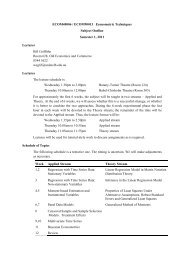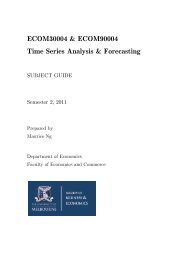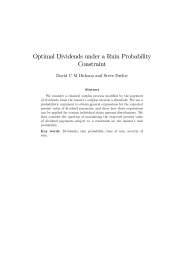A Model of Optimal Corporate Bailouts - Faculty of Business and ...
A Model of Optimal Corporate Bailouts - Faculty of Business and ...
A Model of Optimal Corporate Bailouts - Faculty of Business and ...
Create successful ePaper yourself
Turn your PDF publications into a flip-book with our unique Google optimized e-Paper software.
firms. 4 However, if government really views itself as a taxpayer-sponsored vulture fund, thengovernmental action is likely ill-suited to address most social externalities problems.Fourth, government may simply be too wasteful to function effectively as a tax administratoror overseer <strong>of</strong> rescued firms. This undermines the attractiveness <strong>of</strong> government interventionswrit large. However, our model is robust to the introduction <strong>of</strong> waste at moderate levels, whichtend to shrink—but not necessarily eliminate—the contingencies where efficient bailouts arefeasible <strong>and</strong> desirable. Of course, when governmental waste grows prohibitively large relativeto the social benefits <strong>of</strong> bailouts, the efficiency case for intervention disappears altogether.Fifth, our model considers one bailout at a time. In a crisis, many firms may simultaneouslyneed capital, possibly making government less inclined to h<strong>and</strong> out subsidies. On the otherh<strong>and</strong>, it is plausible that deadweight losses arising from liquidation are higher during crises,which should induce government to be more inclined to bail out firms.Finally, even when bailouts are justified on efficiency grounds, they may not win popularsupport among the most focal (or vocal) constituencies. Indeed, we show that the distribution<strong>of</strong> costs <strong>and</strong> benefits from bailouts in our model would likely augur resistance among theChamber <strong>of</strong> Commerce, the <strong>Business</strong> Roundtable, <strong>and</strong> (perhaps) labor unions: viewed ex ante,even optimal bailouts leave them worse <strong>of</strong>f. (Of course, the same parties will not fight bailoutsin actual distress if they can then avoid complete expropriation.) Naturally, when one factors inthe benefit <strong>of</strong> other stakeholders as well, optimal bailouts remain welfare enhancing.Our paper now proceeds as follows. Section 1 describes the model setup, characterizes thefirst-best solution, <strong>and</strong> formally states the optimal bailout design problem. Section 2 analyzesthe constraints, working backwards through the equilibria at each stage. Section 3 characterizesthe terms <strong>of</strong> an optimal bailout. Section 3.1 illustrates the model solutions graphically. Section 4discusses a number <strong>of</strong> extensions to the base model, including the potential inefficiency <strong>of</strong>replacement managers, access to alternative sources <strong>of</strong> public funds, firm heterogeneity, <strong>and</strong>the possibility <strong>of</strong> holdup by bailout recipients. Section 5 revies some related literature, <strong>and</strong>Section 6 concludes.1 Framework <strong>and</strong> <strong>Model</strong>Our model’s main ingredients are as canonical as possible. A firm has a project that has anup-front investment cost, <strong>and</strong> positive revenues if the project succeeds. The success probabilityincreases with the effort <strong>of</strong> a manager who dislikes effort but can be motivated with a successcontingentwage. The model’s innovations are that a failing firm has a second opportunity totry to restart the project (at a cost) <strong>and</strong> that the government can intervene.4 For example, in its March 2011 report, the TARP Congressional Oversight Panel notes that the US Treasury<strong>of</strong>ficials at times tended to alternate inconsistently between articulating social welfarist goals (e.g., employment,economic growth, investment) <strong>and</strong> recouping a return on investment for taxpayers (?, page 188).7
















